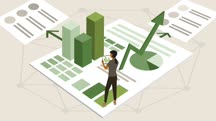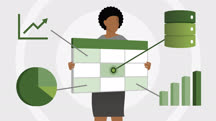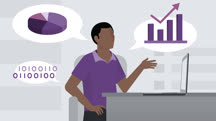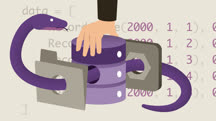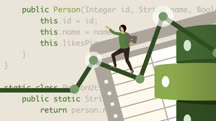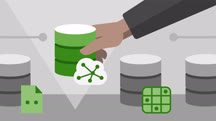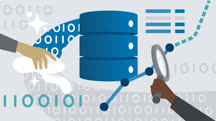Course catalog
Categories
Showing 2,381-2,400 of 8,871 items.
Data Analytics for Students
Analytics is such a broad topic that it's hard to know where to get started. In this course designed for students, explore how to use data analytics to make informed decisions.
Data Analytics: Dashboards vs. Data Stories (218158)
In the world of data analytics, you're consistently presented with the same decision when it comes to how you'll communicate your data and insights. For each project, you need to decide whether to use a dashboard or tell a data story. In this course, business intelligence architect Sara Anstey provides you with the necessary information you need to make this decision with confidence. First, Sara covers the fundamentals of making decisions with data and shares how the role of a data analyst makes this possible for organizations. She then dives into the topics of data science dashboards and data storytelling, highlighting the pros and cons of each and providing the details you need to determine which approach is right for you. Sara closes by recapping key concepts, leaving you prepared to pick between each of these options with ease and intentionality.
This course was created by Madecraft. We are pleased to host this training in our library.

This course was created by Madecraft. We are pleased to host this training in our library.

Data Analytics: Graph Analytics (213806)
Since the inception of data analytics, the way in which analysts view and interpret data has evolved tremendously. New technologies, tools, and approaches have advanced what's possible with data analytics, and network analysis is no exception. In this course, longtime data analyst and data visualization expert Heather Johnson shares the fundamentals of using graph analytics, or network analysis, when analyzing data. Heather begins by reviewing the components of a network analysis and detailing the advantages of using a graph analytics approach. She then walks through key applications of using graph analytics when reviewing data. To wrap up the course, Heather discusses career opportunities within the realm of graph analytics. Upon completion, you’ll be equipped with the knowledge of what graph analytics is and how it can be leveraged within your analytics career.
This course was created by Madecraft. We are pleased to host this training in our library.

This course was created by Madecraft. We are pleased to host this training in our library.

Data Curation Foundations
Add data curation to your data science tool kit. Learn how to develop curation files to document information about datasets and related business processes.
Data Dashboards in Power BI
Build and use optimal data dashboards with Microsoft Power BI. Learn how to design and customize the setup of visuals and charts to make your findings easy to understand.
Data Driven: Harnessing Data and AI to Reinvent Customer Engagement (getAbstract Summary)
Learn how technology can support marketing in the digital era, in this audio-only summary of the popular book by Tom Chavez, Vivek Vaidya, and Chris O’Hara.
Data Ethics: Making Data-Driven Decisions
Learn how to design computer algorithms to be more ethical when making complex decisions.
Data Ethics: Managing Your Private Customer Data
Learn how to make informed, ethical decisions on how to use your customer data.
Data Ethics: Watching Out for Data Misuse (220504)
Technology has given organizations an opportunity to work with data in interesting new ways, but now governments, citizens, and customers are taking a close look at how companies use or misuse data. If one of your customers posts harmful information, should you take it down? Can you use data to manipulate your customer’s behavior? The answers to these questions have an enormous impact on how your customer views your organization. Yet, these decisions aren’t happening in the boardroom. Instead, they’re made in much smaller meetings by people just like you. Instructor Doug Rose gives you the understanding and skills you need to discuss these issues in a way that's both meaningful and productive. Doug begins with ethical views that you need to consider. He goes over ways data can be misused, by a company and by a customer. Then Doug goes over the responsibility to be accurate and what you can do when inaccurate materials are propagated. He concludes with an overview of data challenges. This course was created for LinkedIn Learning by Doug Rose. We are pleased to offer this training in our library.
Data Fluency: Exploring and Describing Data
Learn how anyone, in any industry, can speak the language of data analysis. Find out how to prepare data, explore it visually, and describe it using statistical methods.
Data for Good: Using Data Science in Nonprofits and NGOs (226080)
The revolution in data science has transformed, for better or worse, the way companies do business in the last few decades. But data science isn't just for capitalists. AI is one of the most important forces for change developed in the last century, and we've only begun to recognize its true power and potential. In Data for Good: Using Data Science in Nonprofits and NGOs, Martin Kemka examines how data science and machine learning can be used outside of the for-profit sector. He covers parameters for how data works to influence our world, how the data-for-good concept can be applied, how to determine the best problems to solve with data, and what tools are needed. Martin also provides real-world case studies and challenges to further illustrate the lessons.
Data Ingestion with Python
Learn how to use Python tools and techniques to solve one of the main challenges data scientists face: getting good data to train their algorithms.
Data Rights Foundations
Learn what rights you have to your own data—and what responsibilities businesses and institutions have to protect and respect those rights.
Data Science & Analytics Career Paths & Certifications: First Steps
Learn about the jobs and most valuable certifications available in big data, data analytics, and data science.
Data Science for Java Developers (225281)
Learning the basics of data science and how to apply them in Java opens up a world of possibilities for you, in terms of building software and job opportunities. In this course, instructor Shaun Wassell takes you through the skill sets required for data science, shows you how to visualize data in Java, and explores different methods of turning data into information. Shaun introduces some basic concepts and examples of data science, then walks you through the process of representing data in Java and some difficulties you may encounter. He discusses data manipulation techniques like mapping, filtering, collecting, and sorting. Shaun describes how to find, gather, clean, manipulate, and store data, so that you can start doing useful things with it. Next, he shows you the fun part: different methods you can use to turn data into information. Shaun covers Nearest-Neighbor, Bayes, linear regression, decision trees, clustering, and more.
Data Science Foundations: Choosing the Right Database
Discover how to select the right database for your data science project. Learn about the strengths and weaknesses of different database technologies and review specific use cases.
Data Science Foundations: Data Assessment for Predictive Modeling
Explore the data understanding phase of the CRISP-DM methodology for predictive modeling. Find out how to collect, describe, explore, and verify data.
Data Science Foundations: Data Engineering
Discover the basics of big data with a data science expert. Learn about how to perform core data engineering tasks including staging, profiling, cleansing, and migrating data.
Data Science Foundations: Data Mining
Get started in data mining. Discover data mining techniques such as data reduction, clustering association analysis, and more, with data mining tools like R and Python.
Data Science Foundations: Data Mining in Python (209862)
Data mining is the area of data science that focuses on finding actionable patterns in large and diverse datasets: clusters of similar customers, trends over time that can only be spotted after disentangling seasonal and random effects, and new methods for predicting important outcomes. In this course, instructor Barton Poulson introduces you to data mining that uses the programming language Python. Barton goes over some preliminaries, such as the tools you may use for data mining. He discusses aspects of dimensionality reduction, then explains clustering, including hierarchical clustering, k-Means, DBSCAN, and more. Barton covers classification, including kNN and decision trees. He goes into association analysis and introduces you to Apriori, Eclat, and FP-Growth. Barton steps you through a time-series decomposition, then concludes with sentiment scoring and other text mining tools.


